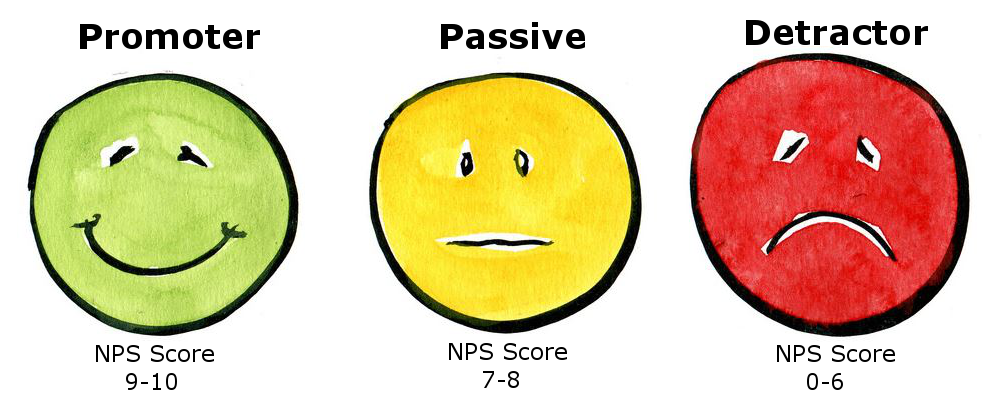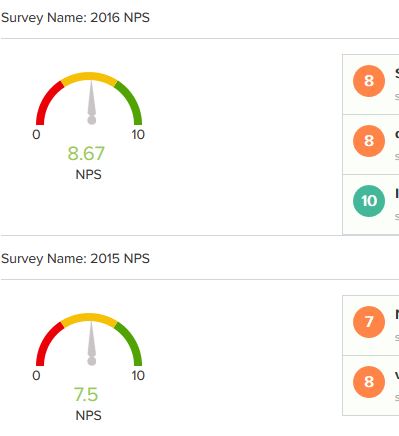What is the Net Promoter Score and how can you use it to understand how you are doing with your customers? This article will cover everything you need to know about the Net Promoter Score, and how to build an NPS Survey.
Net Promoter Score Definition
The Net Promoter Score is a metric that is promoted as being correlated to ‘Customer Loyalty’. Originally created by the consultancy firm, Bain & Company & software firm Satmetrix; the score is based on a simple scale of 1-10.

When a respondent’s score falls within the 9 or 10 range, they would be considered Promoters. Promoters are your loyal customers who will advocate internally and act as your customer champion.
People who respond with a score between 7 or 8 are known as Passives. Passives are customers who may be satisfied, but most likely will not go out of their way to sing your praises or be a customer advocate.
At the other end of the spectrum – if the responses to your survey fall within 0-6 on the scale, the respondents would be considered Detractors. Detractors on the NPS survey are respondents who would be those unhappy customers who do not enjoy your product or service, and may speak badly to friends or colleagues.
Net Promoter Score Questions
The Net Promoter Score, as designed, is based on only one question:
On a Scale from 0-10, with 10 being the highest – how likely are you to recommend our product to a friend or colleague?
This question should allow a selection of scores on a scale of 0-10, and is typically followed up with an opened ended question. Why?
The question begs the question “Why did you respond the way you did?” This answer is more qualitative in the results – meaning you cannot lump these responses without further manipulation of the data set. This “Why?” follow up question has responses that can range from describing the ease of use of your system or tool, their experience within the customer journey, and much more.
Net Promoter Score Calculation
The Net Promoter Scores are not necessarily calculated by taking the average (the mathematical ‘mean’) of the responses, but by taking the percentage of where the detractors respond, minus the aggregate percentage of promoters – to get your score. While complex, the simple methodology we’ve found that works is to just take the average ‘mean’ calculation:

Based off of the numerical responses in the survey, you will have your overall NPS score. Below, I will share an example of two years of Net Promoter Score results. Let’s say that in the 2015 survey, let’s imagine we had two results, 7 & 8, when added together = 15, and divided by the two responses leaves us with a score of 7.5. However, in 2016, we had three responses, 8, 8, & 10. These summed will be 26, and divided by the three results leaves us with a score of 8.67. In this figurative example, the scores are improving, from 7.5 -> 8.67 – which would indicate a good sign overall. Visually, this will look something like the below:

Net Promoter Score Example
The Net Promoter Score is not just the question, “On a Scale from 0-10, with 10 being the highest – how likely are you to recommend our product to a friend or colleague?”, but should also include an open-ended question to have the respondent explain the reasoning behind their given score. This qualitative feedback can provide insight on where you can improve your business, & what your customers view you are doing well in. Open-ended responses can be along the lines of “I’ve received terrible customer service/support” to “Your rep, X, has been a pleasure to work with”. Taken along with the score, you should be able to paint a good picture on where your customer’s loyalty is.
Why Use the Net Promoter Score?
The Net Promoter Score is not without it’s criticisms, however, can show year over year growth based on the feedback from the team given the survey results. I will list some of the criticism I’ve experienced below.
Closing the Loop
One potential pitfall of just relying on the just the Score from the NPS survey is not closing out the loop with customer by providing feedback. While a generic “Thank you for your response.” is great, following back up with the customer in an individualized manner will give you a chance to share your appreciation of their feedback more. This is especially in the case of your Promoters/Champions. Close the loop with your customer and thank them for their time, and let them know that their feedback will be discussed internally and help address any issues that they are currently facing.
Personalization
Since the NPS Survey will take into consideration overall teams or your entire customer base, it sometimes loses the individual aspect of it. By diving deep into the follow up “Why?” question and looking at individual responses, you can avoid the pitfall of viewing the lump score. This also relates the closing the loop, in that you need to not only look at responses and see the forest for the trees, but you also need to dive deep and inspect each tree. You need to understand what made a detractor give their negative review, and what a promoter has said to give the positive response. These responses may not be mutual exclusive, or they may be entirely uncorrelated. An example could be that a detractor hates the interface, but the promoter loves it – by digging into the personal responses, you realize that the Detractor uses Internet Explorer, while the Promoter uses Chrome. A potential fix can be to either show a message on IE that it is unsupported, or work to support IE for your customer base. Another answer could describe the increasing cost of your service, while a factor to consider, should provide insight into why they responded the way they did.
How Do You Improve?
Ultimately, the NPS Score is meant to gauge where you stand with your customer base, and set a course on how to improve. With a constantly changing market landscape and customer base, this can be a slippery slope if it is the only score you use to drive forward your business. If a company focused all of it’s resources on improving the NPS Score – other things such as profitability, time to market, etc can fall to the wayside.
I am a proponent of using data points such as the NPS Score to influence how a company can improve. Now that you understand what the Net Promoter Score is, and why to use it – what are your thoughts on it? What other metrics do you use to see how well your organization is doing? Feel free to reach out, or let me know in the comments!